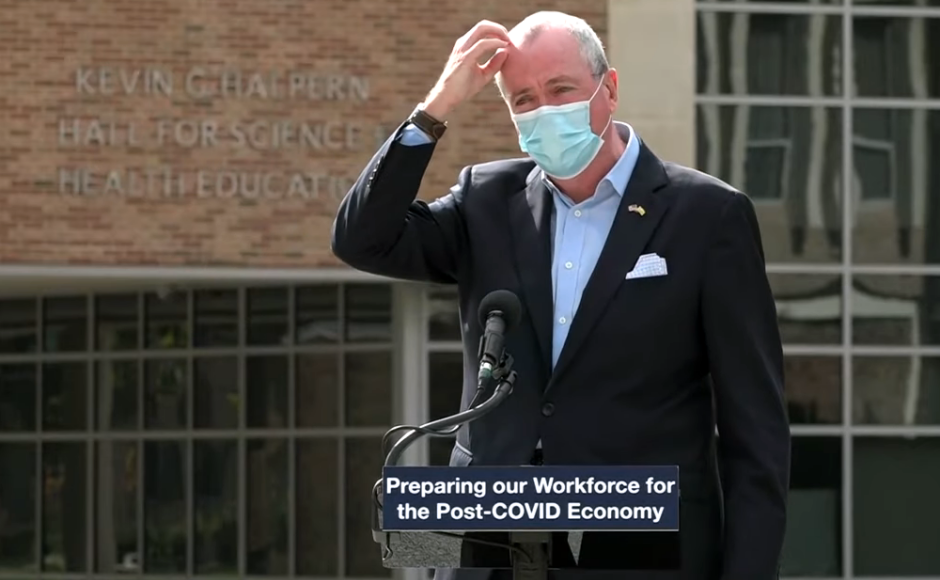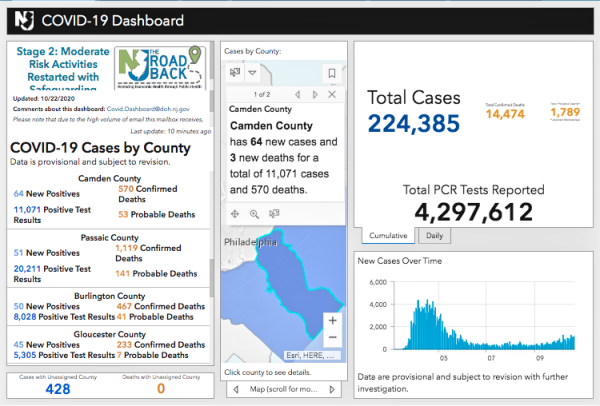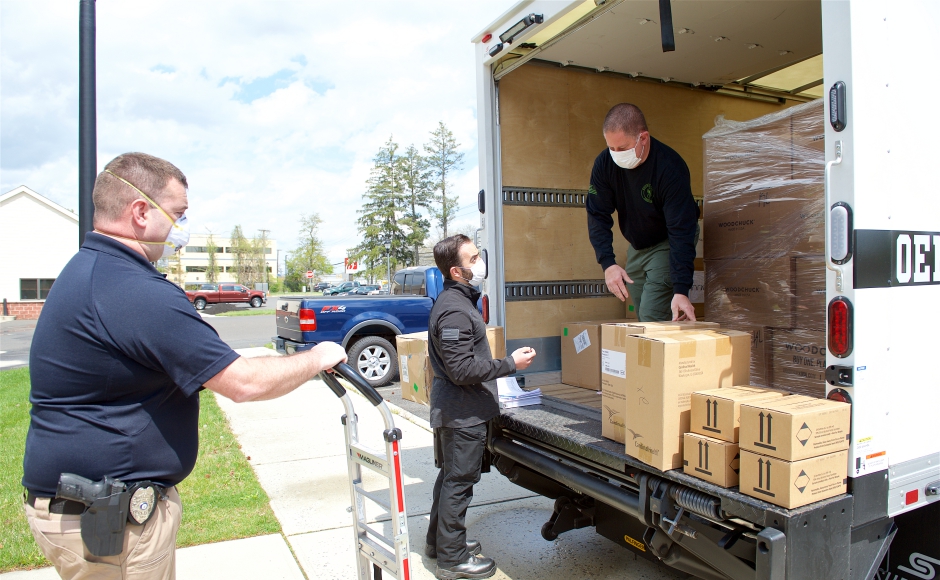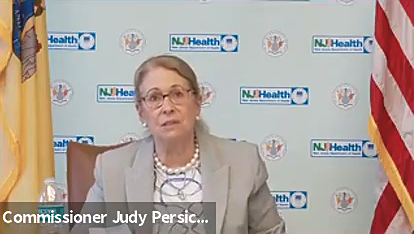Notified of a potential COVID-19 exposure yesterday, Gov. Phil Murphy remains quarantined, and has not tested positive. Hospitalizations hit three-month highs, deaths hit double digits for a third straight day.
By Matt Skoufalos | October 22, 2020
Another 1,182 New Jersey residents have tested positive for novel coronavirus (COVID-19), bringing the statewide total to 224,385 cases, Governor Phil Murphy reported Thursday.
Sadly, 18 more residents have perished from complications related to the virus, bringing the statewide death toll to 14,474 lives lost during the pandemic.
It’s the second day in a row the state has recorded 18 COVID-19-related deaths, and the third in a row of double-digit, COVID-19-related deaths, Murphy said.
In addition to those lab-confirmed fatalities, the state has acknowledged another 1,789 probable COVID-19-related deaths.
Since March, 279 of every 100,000 New Jersey residents have been hospitalized with COVID-19, and 165 of every 100,000 have died from COVID-19-related complications.
More than 4 million people have been tested for the virus statewide, with a 2.55-percent positivity rate per 100,000 residents.
Rate of transmission (Rt) at 1.17, spot positivity lowest in South Jersey
The statewide average of COVID-19 spot positivity testing stood at 5.28 percent October 18; in South Jersey, it was lowest, at 3.66 percent.
Rt, the variable that describes the seven-day, rolling-average rate of transmission of new COVID-19 cases, hit 1.17 from samples taken October 20.
An Rt figure greater than 1.0 means that each new COVID-19 patient is infecting more than one other person, on average, and the spread of the virus is increasing.
Since its mid-April COVID-19 spike, the highest reported RT in New Jersey was 1.48, recorded August 1. The lowest was 0.62, recorded June 9.
Long-term care accounts for half of all deaths, 18 percent of those infected
The recent spikes in new COVID-19 patients has led to three-month highs in hospitalizations, to double month-ago levels, the governor reported Thursday.
Throughout New Jersey, 852 people currently are hospitalized with a case of COVID-19. Of those, 628 have tested positive for COVID-19, and 224 are awaiting confirmation of their symptoms.
Among those hospitalized patients, 187 are in intensive or critical care, and 74 of the ICU and critical-care patients (40 percent) are on ventilators.
Across the state, 771 long-term care (LTC) centers have reported at least one case of COVID-19, and 156 are dealing with an active outbreak. LTCs account for 39,410 infected patients and staff in New Jersey, or 18 percent of total cases.
That includes 25,477 residents and 13,933 staffers sickened by the virus, as well as 7,189 lab-confirmed resident and staff deaths (50 percent of the statewide total), with facilities self-reporting 121 staff deaths.
Of 656 veterans residing in a state-run home, 408 residents have tested positive for COVID-19, and 149 have died from complications related to the virus. Nine veterans presently are hospitalized with COVID-19, and 257 have recovered from the virus. The U.S. Department of Veterans Affairs is also providing additional staffers for New Jersey veterans homes.
At state-run psychiatric facilities, 223 of 1,175 patients and 538 staff members have tested positive for COVID-19. Thirteen patients and seven staffers have died from complications related to the virus.
To date, 59 New Jersey children aged 1 to 18 have been diagnosed with pediatric multisystem inflammatory syndrome, New Jersey Health Commissioner Judy Persichilli said.
All those pediatric patients have tested positive for an active COVID-19 infection or the presence of COVID-19 antibodies, indicating exposure to the virus. No deaths have been associated with this syndrome in New Jersey, although several children have been hospitalized during their treatment.
Since August 1, 25 COVID-19 outbreaks encompassing 111 individual cases have been traced to schools in 13 New Jersey counties. In Camden County, three outbreaks have been linked to 33 cases.

Governor Phil Murphy excuses himself from a jobs briefing at Camden County College, 10-21-20. Credit: NJ Pen.
Close-quarters social gatherings blamed for surge in cases
Dinner parties, birthday parties, “getting together to watch a football game,” are the culprits behind the new increases in cases, Murphy said, urging people not to gather beyond their immediate household or social bubbles.
“A lot of this [community spread]is outside of the so-called public square,” he said.
“It’s in places that are hard to regulate and even harder to enforce compliance.”
The governor believes it was just such a gathering on Saturday—among members of his senior staff—that led to his own potential exposure to a COVID-19-positive person. Murphy received the notice yesterday during an appearance at Camden County College, and promptly left to quarantine at home with family.
The governor remains asymptomatic, and has tested negative twice since Monday; meanwhile, Mike Delamater, his deputy chief of staff for intergovernmental affairs, and Daniel Bryan, his senior advisor for strategic communications, have both tested positive for the virus.
CDC modified definition of close contact
The U.S. Centers for Disease Control (CDC) updated its definition of the nature of the kind of “close contact” that can expose someone to COVID-19.
The change was made after a study revealed that “frequent, brief exposures to an individual with COVID-19 might lead to spread of the virus,” Persichilli said.
“Close contact” now includes being within 6 feet of an infected person for a total of 15 minutes over a 24-hour period, which means that smaller exposures can add up to the same risk as a prolonged encounter.
Transmissibility now depends upon whether the infected person has COVID-19 symptoms, is likely to generate respiratory droplets through coughing and sneezing, and environmental factors, such as the adequacy of ventilation in the area, local crowding, and distance from the subject.
“What this all emphasizes is just how important case investigation and contact tracing is,” Persichilli said, noting that “more than half of [NJ] residents consistently refuse to provide information about their potential exposures.”
Read our ongoing round-up of COVID-19 coverage here.
Please support NJ Pen with a subscription. Get e-mails, follow us on Facebook, Twitter, and Instagram, or try our Direct Dispatch text alerts.








